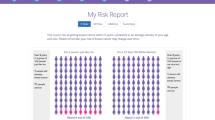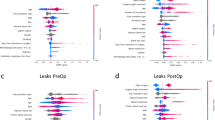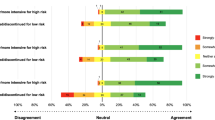Abstract
Assessments of risk are a critical part of the practice of evidence-based medicine. Comprehension of various risk measures, such as absolute risk, relative risk, attributable risk, odds ratio, and hazard ratio, is essential to understand the medical literature, and to communicate health risks effectively. Complex risk measures, including number needed to treat and survival estimates that are adjusted for competing risks, are often misunderstood. Communication of these concepts to patients can be a challenge. The patient's perception of risk stems not only from the way risks are stated, but also from family history, personal experiences, cultural norms, and beliefs. A multifaceted approach to risk communication that uses both qualitative and quantitative assessments of risk, and addresses the timing and permanence of risks, is necessary to ensure the patient understands the potential risks. Successful communication involves interaction with the patient to understand the patient's perspective and to aid in personalized decision-making. In the face of uncertainty, making a provisional decision with a plan to review it later can be a good strategy. Verifying the patient's comprehension can help ensure that the decisions reached are informed and acceptable.
Key Points
-
The absolute risk, risk difference, relative risk and odds ratio are risk measures that pertain to the development of an outcome at a specific time point (fixed-time measures)
-
The risk ratio and hazard ratio are risk measures that pertain to the rate of development of an outcome over a period of time (rate-based measures)
-
Many complex risk measures, such as the number needed to treat, relative risk reduction, and survival estimates adjusted for competing risks, are derived from other risk measures
-
The patient's perception of risk stems from many sources, such as family history, personal experiences, cultural norms, and beliefs
-
Physicians should engage in a thorough discussion, which addresses the timing, permanence and severity of risks, and uses a variety of risk measures, to ensure that patients understand the potential risks
-
Making a provisional decision based on current information and perceptions with a planned review at a later date is a reasonable approach in the face of uncertainty, because it allows for inclusion of new information
This is a preview of subscription content, access via your institution
Access options
Subscribe to this journal
Receive 12 print issues and online access
$209.00 per year
only $17.42 per issue
Buy this article
- Purchase on Springer Link
- Instant access to full article PDF
Prices may be subject to local taxes which are calculated during checkout

Similar content being viewed by others
References
Edwards A and Prior L (1997) Communication about risk—dilemmas for general practitioners. The Department of General Practice Working Group, University of Wales College of Medicine. Br J Gen Pract 47: 739–742
Curran E et al. (2000) Lightning casualties and damages in the United States from 1959 to 1994. J Climate 13: 3448–3453
Spruance SL et al. (2004) Hazard ratio in clinical trials. Antimicrob Agents Chemother 48: 2787–2792
Davies HTO et al. (1998) When can odds ratios mislead? BMJ 316: 989–991
Schechtman E (2002) Odds ratio, relative risk, absolute risk reduction, and the number needed to treat—which of these should we use? Value Health 5: 431–436
Uter W and Pfahlberg A (2001) The application of methods to quantify attributable risk in medical practice. Stat Methods Med Res 10: 231–237
Kaplan EL and Meier P (1958) Non-parametric estimation from incomplete observations. J Am Stat Assoc 53: 457–481
Pocock SJ et al. (2002) Survival plots of time-to-event outcomes in clinical trials: good practice and pitfalls. Lancet 359: 1686–1689
Gooley TA et al. (1999) Estimation of failure probabilities in the presence of competing risks: new representations of old estimators. Stat Med 18: 695–706
Nicola PJ et al. (2005) The risk of congestive heart faliure in rheumatoid arthritis: a population-based study over 46 years. Arthritis Rheum 52: 412–420
Bogardus ST Jr et al. (1999) Perils, pitfalls, and possibilities in talking about medical risk. JAMA 281: 1037–1041
Hunt DL et al. (2000) Users' guides to the medical literature: XXI. Using electronic health information resources in evidence-based practice. Evidence-Based Medicine Working Group. JAMA 283: 1875–1879
Montori VM et al. (2004) Users' guide to detecting misleading claims in clinical research reports. BMJ 329: 1093–1096
van der Heijde D et al. (2005) Presentation and analysis of data on radiographic outcome in clinical trials: experience from the TEMPO study. Arthritis Rheum 52: 49–60
Casarett D (2006) The median in not the (only) message. Ann Intern Med 145: 700–701
Gould SJ (1985) The median is not the message. Discover 6: 40–42
Griffiths F et al. (2005) The nature of medical evidence and its inherent uncertainty for the clinical consultation: qualitative study. BMJ 330:511
Sheridan SL et al. (2003) A randomized comparison of patients' understanding of number needed to treat and other common risk reduction formats. J Gen Intern Med 18: 884–892
Hux JE and Naylor CD (1995) Communicating the benefits of chronic preventive therapy: does the format of efficacy data determine patients' acceptance of treatment? Med Decis Making 15: 152–157
Ghosh AK and Ghosh K (2005) Translating evidence-based information into effective risk communication: current challenges and opportunities. J Lab Clin Med 145: 171–180
Edwards A et al. (2002) Explaining risks: turning numerical data into meaningful pictures. BMJ 324: 827–830
Wilson R and Crouch EA (1987) Risk assessment and comparisons: an introduction. Science 236: 267–270
Council NS (online 11 April 2005) What are the odds of dying? [http://www.nsc.org/lrs/statinfo/odds.htm] (accessed on 24 November 2006)
Gurm HS and Litaker DG (2000) Framing procedural risks to patients: is 99% safe the same as a risk of 1 in 100? Acad Med 75: 840–842
Rudd RE et al. (2003) Leave no one behind: improving health and risk communication through attention to literacy. J Health Commun 8 (Suppl 1): 104–115
Fuller R et al. (2001) Risk communication and older people—understanding of probability and risk information by medical inpatients aged 75 years and older. Age Ageing 30: 473–476
Epstein RM et al. (2004) Communicating evidence for participatory decision making. JAMA 291: 2359–2366
O'Donnell S et al. (2006) Understanding and overcoming the barriers of implementing patient decision aids in clinical practice. J Eval Clin Pract 12: 174–181
Author information
Authors and Affiliations
Corresponding author
Ethics declarations
Competing interests
The authors declare no competing financial interests.
Rights and permissions
About this article
Cite this article
Crowson, C., Therneau, T., Matteson, E. et al. Primer: demystifying risk—understanding and communicating medical risks. Nat Rev Rheumatol 3, 181–187 (2007). https://doi.org/10.1038/ncprheum0397
Received:
Accepted:
Issue Date:
DOI: https://doi.org/10.1038/ncprheum0397



